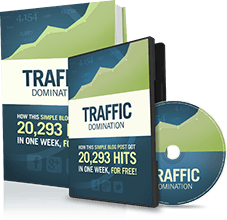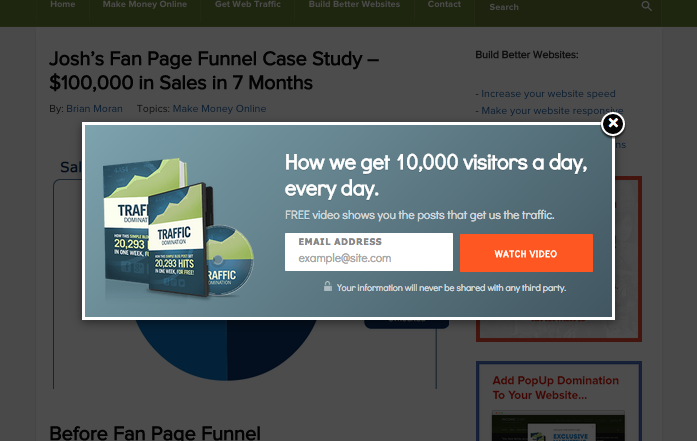Creating and Selling Software Online – How Josh Built a 7 Figure Business
Josh Bartlett was working as a manager in a bank in the UK when he first discovered selling on eBay.
During his lunch break, Bartlett would buy products from local stores and flip them online for a profit. It started as a hobby, but Josh soon became one of the country’s first “Platinum Power Sellers” on Ebay.
Bartlett decided to write an ebook on how to make money selling on Ebay. He priced it online at about $40 and was soon making a consistent income. Just like that, Bartlett was hooked on the idea of selling his own products online – ones that would never run out of stock.
Josh Bartlett Today
Bartlett has since moved from selling ebooks to software. His product, Easy Video Suite provides a platform to help people build their email list and make sales through interactive video. The highly successful product has gone through several iterations in the last few years and now even includes the ability to record and edit video as well.

What You’ll Learn
- Refining an Idea for Software
- Why Software Sells
- Where to Find Coders
- How to Manage a Team
- The Two Lists You Need
- How to Deliver Your Software Product
- The Importance of Customer Support
- The Future of Software Creation
Getting Started With Making Money Creating & Selling Software
Identify a Problem to Solve
The very first thing that we is ask, “What are the common problems out there right now?”
A lot of people like to think that their problems are unique to them and so they’ll sit there and think, “I wish that I knew how to do this like everybody else does.” But problems are not unique. And that means that if you can solve your own problems, then you’re going to find a marketplace of customers who want to buy that solution.
Since we know nobody as much as we know ourselves, we always start with us. We look at our own problems and ask, “In a perfect world, what do I wish somebody would come along and give to me as a solution that problem?”
The Power of Offering a Solution
The two most powerful ways to sell something to somebody is to either solve their problem or prevent a problem, in that order.
If you can solve somebody’s problem, they’re going to be very, very thankful. They’re also definitely going to buy. If you can prevent it, they’re also going to be very interested in that.
Market Analysis
Then we’re going to look at the market. We’re going to look at social media, forums, and our customer base. People will tell you what they want if you listen to them and if you give it to them, they will buy it. People often don’t look at their most valuable asset (which is their customers) and listen to the feedback.
It’s literally that simple. By looking online, we can find out if the problem is one that a lot of people are struggling with, a few people are struggling with, or everybody is struggling with. Based on that, we can decide how important the product is.
Find out what people want and then give it to them. You don’t have to convince people to buy stuff that they don’t already want. You’ll find that you really don’t have to do a huge amount of marketing because they will come to you.
Keep it Simple
No idea is too small. It’s not about the number of buttons you have or the amount of features. Users are paying for the benefit and the solution of a problem. Sometimes the simplest product is the best product that you can make.
Think of your product like an elevator pitch. Can you describe it in a short elevator ride? What is this product? Why does it benefit me and why should I buy it? If you can’t explain it simply, then it probably already is too complex.
Sometimes the more we put in it, the more bloated the product becomes.
Benefits to Software as a Product
High Value
We all know at this point that it has a much higher perceived value than ebooks and video products. There are just not as many software products around, especially good ones.
One reason why software has such a high perceived value is that we’re conditioned to spend more on software. Look at Adobe Photoshop, which can cost thousands of dollars to buy, versus the most expensive book you’ve ever bought. Therefore we’re more likely to spend more for software.
Secondly, not everybody can make software. Although it’s not that difficult, it’s definitely a lot easier to type on a keyboard and write an ebook. Because software has a higher barrier to entry, it is perceived as being of higher value.
Safeguarded
It’s also harder to copy. With text, you can obviously copy and paste something and then you can put it elsewhere.
Unfortunately, that does happen. With software, you can basically build in very simple safeguards to stop people from easily being able to just take it and put it elsewhere without paying for it. So that really attracted me from day one.
Effective
Software can really solve people’s problems probably better than anything else. Software is kind of magical because if you think it, you can make it. There’s only so much you can do with a book or a video. But software can actually guide you through a process while you’re on screen and make it interactive.
Less Competition
With software, it takes longer to make the product (compared to ebooks or video), so you’ll find that it is harder for the competition to catch up. You’ll have more longevity with a software product.
EasyVideoPlayer has been around for a couple of years and it’s still selling very strong today.
User Feedback
With software, you can really track what people are doing. I know what tabs people are clicking on, what buttons people are clicking on, and what pages they’re in. In new versions, we’ve got things built in, if people click for support on a specific page, it will tell me exactly what they were doing at that point.
Obviously, this is all without sharing any personal information. It just allows you to get intelligent information which helps you make better products in the future.
Market Differentiated
Anything can be software.
You can take an information product and turn it into software by making it a web app. If you do that, then immediately you are unique in your market place. You’re not just another ebook. You are probably one of the only software solutions.
Finding and Working with Software Developers
Quality First
I find that a lot of people are trying to save money, so they ask, “Where’s the cheapest place I can outsource to?” That’s not the question you need to be asking. At the end of the day, you need to be looking at who’s going to be giving you the best quality product.
I’ve seen so many people make the mistake of trying to save money up front just to lose 50% of the sales they could have had in the back end. They end up saving a couple of hundred dollars to lose thousands and thousands of dollars later on down the road.
I’ve had success in using Upwork. You won’t find the cheapest people on Upwork. There are other forums and outsource areas that are cheaper. But I do find that you get better quality.
But my biggest trick and tip for finding really good, motivated people to work for you is to go to coding forums where the coders hang out. A lot of coders code because they love it; it’s a pastime for them. Therefore, whereas a music enthusiast might be in a music forum, a coding enthusiast might be in a coding forum talking about the new changes to a coding language.
So if you go directly into that forum and just spend a couple of days keeping an eye on the posts and the threads, you’ll start to see the thought leaders.
There might be five or so on each forum. Approach those people directly and explain to them that you have a vision for something really exciting, a great project. You’ve noticed that they’ve stood out to you and you think that they could do a great job of helping them with this project.
You’ve appealed to their ego and you have given them a money-making opportunity (a lot of these people code for free). After a very short space of time, you’ll probably find somebody that will be interested. For them, it becomes a very exciting project that they’re going to work on. You’re not just another number and so they’re going to probably do the best work that they can do for you.
It’s Not Automatic
People have this mentality of, “Ok, let’s just outsource.”
Outsourcing is great and of course you do need to do that, but people think that the word ‘outsource’ and ‘automated’ go hand in hand. The truth is that when you’re working with somebody to create your dream, you can’t expect somebody else to do a good job of realizing your vision for the product if you try to automate the entire process.
You can’t just send them one email and say, “Get back to me when it’s made.” You have to get your hands dirty and roll up your sleeves and get involved.
Getting Involved
You don’t have to learn how to code. But you do have to be there with them every step of the way and make sure you give them feedback. A lot of people may not agree, but a coder is a person too. And they’re stuck there trying to make the product.
So answer their questions immediately. Really work with them and keep them motivated. Make sure they understand your dream and your goal and your vision. Make sure they’re excited about it.
You may think, “This is just a coder on Upwork. He doesn’t need to know my grand vision.” But of course he does, because people save their best work for the stuff they’re really passionate about. You can help people be passionate by just working a little bit closer with them.
Feedback System
You can’t just give a list of to-do to somebody and then expect to receive the finished product a month later. You have to get involved in that process, get down in the trench with them, and talk to them about why these changes should be made.
Ask them to send you previews very, very regularly. I get previews weekly, as a minimum. A lot of times, I’m seeing stuff every single day and I’m giving feedback right down to the placement of a button. Although there’s a little bit more work involved in doing it that way compared to being hands-off, you end up with a product that is that much better and that is therefore that much more profitable to you.
Managing the Project
Create Milestones
What’s the best way to eat an elephant?
One slice at a time.
That quite honest saying means that you have to break big things up into bite-sized pieces, otherwise it gets overwhelming. You need to do that with your project.
People often get bogged down because they’re trying to look at the whole picture without breaking it down. So, sit down with whoever’s developing this with you and break it into smaller milestones that you can track.
Milestones as Management
Make your team accountable at each milestone. This milestone needs to be completed by the end of the week. Then once that milestone’s completed, this milestone needs to be completed by the end of the next week. This way, you can find out when you’re a day behind on a particular milestone and you don’t have to be managing the whole project.
Payment by Milestone
You can pay per milestone, rather than paying them up front. You don’t have to split it up equally either. You can say, “This is avery complex milestone that’s going to take a bit longer and this is very integral to the project, so a little bit more money into that one.” This keeps the person engaged and motivated to reach the next milestone and get that extra little bit of money.
Bonuses
I also personally have small bonuses for people hitting milestones early and doing a great job. You don’t necessarily want to rush things, but if they’re doing very well and kicking ass, then I’ll give them a small bonus. It’s all worth it to me in the long run, because if we get something done really well quickly, then I’m going to launch sooner and make more money.
Must-Have List / Wish List
Always attribute the features and the ideas that you come up with either to your must-have list or your wish list. That way, it doesn’t affect the time scale for the overall project.
It doesn’t matter how great your product is: if it’s not launched, it’s not going to make you any money. So, you need to make sure that you’re very strict about keeping your initial vision very simple. The features and improvements on your wish list can always be added in after it’s been launched.
Project Budget
I never, ever, ever pay per hour. Hourly pay makes it in everybody’s interest to take longer, rather than finish more quickly. Also, it’s extremely difficult to track the actual hours that people are working when they’re not right next to you. On top of that, it creates a distrusting environment.
Instead, do a project budget. If you just go to somebody and say, “How much will it cost to develop this?” Well, they don’t necessarily know if you’re a Fortune 500 company or whether you’re just some guy sat in his back room. So they could quote you anything and you’ll see massive ranges of pricing from a couple hundred bucks to tens of thousands of dollars for the same project, depending on what they think they can get for it.
So, you need to set the expectations early. At the end of the day, your budget is your budget. That’s what you have to spend on this. So, work out what your budget is and let people know. In life, as with everything, it pays dividends to be transparent and honest with people.
Clear Thinking Leads to Clear Communication
What you need to do is be very clear about what you want developed before you go to a developer. If you just have an idea and then ten minutes later you’re trying to find somebody to build the idea for you, then you don’t have your idea perfectly formed yet. The problem will be that you get into discussing with somebody and they’ll start asking you all these questions that you didn’t expect. You just get overwhelmed.
So what you need to do is just have a sit-down. Think to yourself, “Here’s my idea. It’s great. Let’s just think about it for a little while and throw it around.” Once you’ve got that perfectly formed picture, then when you go to somebody they will be able to see what you see. That means there’s no confusion and they can do their best work for you.
Testing
Testing is the thing that I think a lot of people brush over and miss. They launch the product thinking, “Oh it doesn’t matter if there’s a problem because my customers can just tell me.”
But you never want people to pay for something and then be your tester. It needs to be working before they get it, because this is their first experience with dealing with you and if they buy something and it just doesn’t work then it’s going to be a bad experience for them from day one. You’re probably going to have to fight very hard to get that customer back. Actually, you’re probably just going to lose them.
So before you get launch this thing, test it and make sure that it’s ready. It’s very, very simple.
All you need to do is use the product in every way possible. Try to break it. Literally sit down and just try to break it. Then once you’ve done that, get your developer to do the same thing. But don’t just rely on them, because your developer is not a user or a customer. They think in code and they don’t necessarily use it in the same way because they made the thing. So get somebody to test it who could be your customer as well.
Once you’ve done that, I think it’s really important to have a beta process. That can just be opening up to some of your friends and people that you know, either in the industry or just in real life, and get them to use it as well and give you feedback and listen.
Just tweaking it can be the difference between a product that just kills it when it comes out and a product that people kind of miss when they hear the idea.
At that point, if you’ve got a customer base already, then roll it out to those people next, before you do a big launch. Then after that you can gear up and get ready for launch.
Selling Software
Do Something Good in a Great Way
There are a lot of products out there that everybody hates because they’re complicated to use, but they still use them because they do really powerful things.
But there aren’t a lot of products out there that do good things and do them in a great way. If you can get that, then you’ve got a hit on your hands immediately, because people use it and they go, “Wow – that was enjoyable to use and it was easy to use.” That’s key.
Marketing
With software, you can make the product the star. What I mean by that is that when you’re trying to sell something abstract like a mastermind membership group, you have to put a story in your sales pitch.
You don’t really need to do that with software. If your product solves a problem, then simply show them that product easily solving the problem. Just make the product the star. Keep things very simple: this is what it does and this is why it benefits you. If you can explain that to people, then they’re going to want to buy it.
Selling More with Affiliates
We wouldn’t have been able to get as many customers without our affiliates. Affiliates have been very, very successful for us. You’re never going to be able to reach as many people as a network of affiliates will.
One of the best affiliate networks for me is ClickBank. You can sign up very simply and very easily. It’s also very simple for an affiliate to start selling your product. You don’t have to do anything.
Delivering Software
Platform
I use WishList Member, which is a great membership site platform, to create a members area. (Optimize Press is another great product where you can do the same thing). They both can integrate with ClickBank as well.
Helping People Use the Product
Some people just take a product, put it in there, and forget about everything else. But it’s extremely important that a user has a good experience with the product the first time that they use it. Otherwise they may think about refunding. Ultimately, we want them to keep the product. If they’re using it, they’re going to talk about it and that’s going to lead to more sales.
Our goal is to get them thinking, “Wow – the transaction I just made to buy this product was well worth it and what a great product it is!”
Videos
Make sure that you surround your software with as much support as possible. You can make “how-to” videos just by recording your screen and using different parts of your software. Keep them quite short and to the point: a minute or two minutes at most. People don’t want to sit through a half-hour training marathon. They’re going to not have time to do it.
Never underestimate how people might still need to understand how to use it, even if it is quite simple. We’re all at different levels of knowledge and ability when it comes to using a computer.
Read: The Ultimate Guide to Making Online Video Tutorials
Checklists
People love checklists and they don’t want to leave them half-finished. So, if they do step one, two, and three out of five steps, psychologically they’re going to want to go back and finish step 4 and step 5.
Whereas if you just say, “Watch this video and then download the software and here is some other stuff you can do…” they may not come back to it.
Customer Support
Categorically, the most money you make will come from after the transaction and how you treat those customers. Ultimately, you want them to be customers for life and to buy your next product. You want people to be talking about your product. The best kind of marketing is a good product and great customer service.
Customers that are happy, who are surprised by how well you treat them, will go out and talk about it on social media and you’ll find that they’ll bring in customers.
Start Off Simple
You don’t want to start off trying to have everything in place. You’re going to start off simple and grow as your customers grow. As your customers grow, so does the money you’re making. That means you can invest in other solutions and you can make things a bit more streamlined.
Systemize Support
We now use a product called Zendesk, which I absolutely love. It’s not necessarily the cheapest service out there, but it integrates really well with pretty much everything and it’s very easy to manage. You can have all your staff working in it at different levels of administration. It gives you great reports and has the ability to let customers give you satisfaction ratings and all that kind of thing.
When you’re just starting out, email is enough. Just having a support email is enough that they can email. What I would recommend doing is having a separate email. You can go into Gmail and create filters as well, but the simplest thing is probably to have an email specifically for the support of this product. Just checking that is enough to begin with.
Be a Hero
Do anything you can to help your customer. Be your customer’s hero.
For example, we have the video player. If they try to incorporate that into WordPress and they have a theme that isn’t compatible and creates a problem, rather than saying, “Well, we don’t make that theme. We advise you don’t use it or go speak to the guy that makes the theme,” we’ll get in there if we have to and work with them on it.
Whatever you can do in your power, do it to help the customer – even if you have to go in and talk with them about it on Skype. The time and effort you put into that initially will pay dividends in sales and reputation in the future.
Looking Forward
The Rise of Software
I think the software part of the industry is going to go from strength to strength. There’s going to be more and more software being made.
Years ago, there was an evolutionary process from ebook to video. That shift created a lot of revenue for a lot of people and it actually helped the way that people learn because videos can be much more effective in teaching people.
Today, I see another shift where a lot of people are willing to take the information that they’ve got and turn it into web apps. You can take pretty much any course and turn it into a software solution, where the content is delivered modularly and it’s interactive. There’s a really big chance for a lot of people right now. It’s wide open.
Better Software
I really hope that people focus on making good, polished products that solve problems. I think we’re going to see a lot more smart, interesting software solutions.
I’ve seen a lot of people create a software product quickly, try to make some money out of it, but then they don’t stick by it. Software does not need to be like that. I stand by my product. We keep working on it and we keep developing it.
A product can be an entire business. It can fuel your entire business and it can do great things for you. So, stick with a product.
Last Words
When you really look at the huge successes that are happening right now around the world, you see things like Draw Something being sold for millions of dollars. You see things like the rise of Facebook, which is a software platform.
We don’t need to be Instagram, which was bought for a billion. But we can take lessons from the amazing staggering successes we’re seeing from companies and say, “Okay, software is something that I need to be involved in. It’s already growing. It’s hot. This is an area that’s very, very interesting and very attractive. There’s a massive amount of potential and opportunity there and we only need tiny percentage of that kind of success to do really, really well.”
Actionable Takeaways
- Choose a problem that software can solve.
Look at the problems that you face online. Other people have those problems as well. No problem is too small. You just need to develop a good solution for it based on customer requests and feedback. - Find a talented coder.
Upwork is good. Also go to coding forums, work through the threads, and find the thought leaders. Send them an email saying that you’d like to pay them to work on a great project of yours. Convince them of your vision, tell them your budget, and get them excited to be involved. - Take an active role in the project.
Sit down with your coder to create a project brief with milestones based on your must-have list and wish list. Tell them how much they’ll get paid at each milestone and offer bonuses if they finish early. Stay in constant communication until the project is ready to test and beta test it by trying to break it. - Set up a system to sell the software.
To sell the software, set up a website or landing page. Drive traffic to it from your existing audience or through affiliates. Once they get there, simply and straight-forwardly communicate how your software solves their problem. If they buy, let them download the software or give them access to use it from your website. - Treat your customers like damsels in distress.
Be a hero to your customers. Start with a simple support email address and eventually upgrade to Zendesk to manage your customer support. When they have a problem, help them as best you can. People talk about wonderful customer service which results in more sales down the road.
Read more: ‘10 Ways SamCart Will Increase Your Checkout Page Conversions’
"Do Not Write Another Blog Post Until You Watch This Free Video..."

Watch this free video to learn...
- How I got over 10,000,000 people to visit my websites.
- The types of blog post that got me all that traffic.
- How to get someone else to do it for you!












Great and indepth post here. even if you interviewed Josh himself, he won’t be able to go deep into all what you said here…
I’m taking some course as regards building software and will soon launch my software soonest.
Sheyi
Been expecting your outstanding, quality and intuitive post for quiet a while, thank God it’s here.
Thanks very much for this great post. I love it, just like every other ones. Please keep it up.
a complete list
this guy seems to be a Product Savy.
knowing what is needed and giving it in a better way.
May I ask Michael, if you asked a coder to build a piece of software for you, something that hasn’t yet been created, what stops them from going and building it themselves? Is it something worth worrying about or not?
David..
Hi Michael. I am considering the idea of having my own software to sell. Thank you for the tips. Your article points out the positive ideas on building a software for everyone to use.
Definitely agree with him that solving a problem is so important – skip that step and all the others will be worthless! It’s just a matter of finding those problems – sometimes it’s easier to find problems of other people’s than your own! I know it is for me!
Thomas
Great article. If a person knows how to create good software the income possibilities are endless.
Very helpful info! Absolutely….solving a problem is always a great first step when figuring out any type of product to sell or create. Like the idea of using that to create software.
Wow! It’s been a while since I visited this site. But you got a real nice post here Michael. Software is indeed difficult to copy and your post has inspired me to build my own something what I have in mind a couple of months ago.
Online software also is a great mailing list builder when you only allow people to use it for trial by submitting their email. Thanks Michael for this inspiring post.
Hey there Michael,
I actually stumbled onto your site while searching through Google for related sites to my niche, and what a lucky day this one was!
I read through your “How you got started” and couldnt leave a comment so I thought I would drop a line here.
Its inspirational to see someone as young as me doing what I aspire to do, you see I am 22 years old and I am starting up my own business online, and it seems like trendsetters like you are there to lead us in the right direction!
I am also being mentored by Alex Jeffreys, and I really think that if I continue to “Help others succeed” I will get there myself!
Thanks again for the great inspirational blog, and look forward to more of it!
Kind Regards
Zayne Thompson
Hey Micheal, I can’t believe how id depth this article is. I am reading tips about building my own software that I have never read before in all of my research on this subject. You are a genius man. Keep it up. Will surely be coming back for more in depth articles. I am now more confident about having my own software to sell online than ever before. If Josh can do it, so can I! Thanks again Micheal.
Josh is the man. He knows what he’s talking about when it comes to developing software. He’s my go-to guy when I need advice on anything business related actually. Super smart dude.
BTW. I like the picture you chose.
Great points on software sales! As a founder of startup I think that some part of work in sales and marketing should be outsourced. You can make a smaller investment to building your marketing plan until your growth provides the cash flow needed to hire more permanent staffing. Also, you often need the expertise of more knowledgeable professionals providing strategic growth plans and your budget doesn’t not allow for that level of investment for the long term.